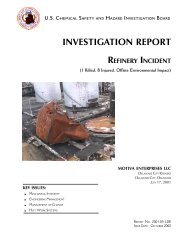Little General Store Propane Explosion - US Chemical Safety and ...
Little General Store Propane Explosion - US Chemical Safety and ...
Little General Store Propane Explosion - US Chemical Safety and ...
You also want an ePaper? Increase the reach of your titles
YUMPU automatically turns print PDFs into web optimized ePapers that Google loves.
<strong>Little</strong> <strong>General</strong> <strong>Store</strong> September 2008<br />
4. An excess flow disk in the valve to limit flow should flow exceed a preset limit, such as during a hose<br />
rupture.<br />
4.3 <strong>Propane</strong> St<strong>and</strong>ards<br />
4.3.1 Occupational <strong>Safety</strong> <strong>and</strong> Health Administration<br />
The OSHA st<strong>and</strong>ard Storage <strong>and</strong> H<strong>and</strong>ling of Liquefied Petroleum Gases 21 establishes specific<br />
requirements for most workplaces 22 storing <strong>and</strong> h<strong>and</strong>ling liquefied petroleum gases (LP gases) 23 ,<br />
including propane.<br />
The st<strong>and</strong>ard’s requirements include, but are not limited to, design, operation, technician training, safety<br />
devices, <strong>and</strong> tank placement. A 500-gallon tank, like the one at <strong>Little</strong> <strong>General</strong>, must be located at least 10<br />
feet from buildings.<br />
4.3.2 NFPA <strong>Propane</strong> St<strong>and</strong>ards<br />
Two NFPA st<strong>and</strong>ards address propane: the National Fuel Gas Code (NFPA 54), which applies to fixed<br />
gas-consuming (including propane) equipment attached to piping, <strong>and</strong> the Liquefied Petroleum Gas Code<br />
(NFPA 58), which applies to the storage, h<strong>and</strong>ling, transportation, <strong>and</strong> use of LP gas. NFPA 58 Chapter 6<br />
addresses installing LP gas systems, including requirements for tank locations. NFPA 58 also requires a<br />
500-gallon tank to be at least 10 feet from commercial <strong>and</strong> residential buildings.<br />
21<br />
29 CFR 1910.110.<br />
22<br />
<strong>Little</strong> <strong>General</strong> is covered by OSHA’s occupational safety <strong>and</strong> health st<strong>and</strong>ards.<br />
23<br />
Liquefied petroleum gas is the general term for mixtures of hydrocarbon gases liquefied by pressure <strong>and</strong> used for<br />
cooking, heating, <strong>and</strong> vehicle fuel. Liquefied petroleum gas can be propane, butane, propylene, butylene or any<br />
mixture of these compounds.<br />
24









